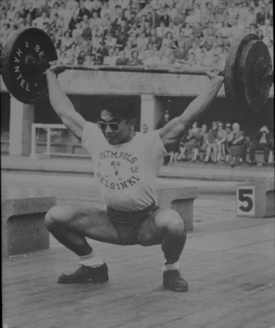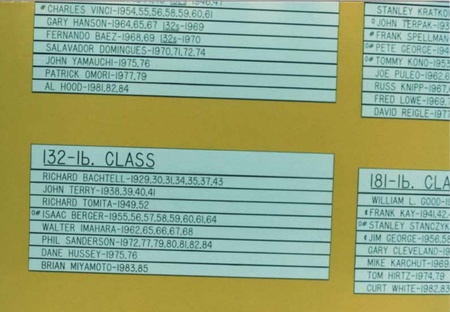Nikkei athletes have won numerous national, world, and Olympic titles in the sport of weightlifting. Richard Tomita, Emerick Ishikawa, and Harold Sakata represented the US at the 1948 Olympics in London, along with Chinese American Richard Tom. Tom took the bronze medal in the bantamweight class, and Sakata took the silver medal in the light-heavyweight class. Sakata later achieved show business fame as Oddjob in the James Bond movie Goldfinger. Along with swimmers and divers, these lifters were in the forefront of Asian American athletes who achieved worldwide recognition.

The 1952 Olympics in Helsinki saw 22-year old Sacramento native Tommy Kono burst onto the world stage as he took the gold medal in the lightweight class, setting a world record in the snatch lift in the process. Thus began Kono’s dominance of the sport for the rest of the decade, repeating as gold medalist (in a heavier bodyweight class) at the 1956 Olympics in Melbourne, and winning the world championship in every intervening non-Olympic year through 1959. In the twilight of his career and hampered by injuries, he took “only” silver at the 1960 Olympics in Rome. A 2016 documentary by then-Sacramento newsman Ryan Yamamoto includes a sports newsreel clip from the 1950s in which the narrator says, “Pound-for-pound, Kono is the strongest man in the world.”
Rare for a weightlifter, Kono also excelled in bodybuilding, winning a Mr. Universe and a few Mr. World titles along the way. His achievements, combined with a scholarly and humble demeanor, made him an idol of generations of “iron game” aficionados worldwide, even an Austrian teenage bodybuilder named Arnold Schwarzenegger. In fact, in Arnold’s 2012 autobiography Total Recall, he states on page 97 that his first trip to Hawaii in 1969 was partly to visit Tommy Kono and Harold Sakata.
I was born in 1952, the same year in which Tommy Kono won his first Olympics. Small and sickly until age 10, I missed school frequently because of illness. Though I never was bullied and was fairly coordinated physically, my performance in sports was limited by fragile health and lack of strength. My dad, who had a background in weight training from his teens and young adulthood, purchased an exercise barbell set. He then led my two brothers and me in thrice weekly workouts in the garage. With a modicum of newly developed strength, I soon could run faster and farther, and do more pull-ups than almost all of my schoolmates. Classwork also improved as I was out sick less often.
After some time, my dad granted us boys the choice to continue or quit. I was the only one to continue in any regular fashion. Though my training was often hit-and-miss, lifting weights definitely helped me make the Gardena High School track team as a long jumper and hurdler.
I took up competitive weightlifting as a hobby in 1972 at age 19, but quit about a year later because I started college full-time while continuing to work full-time in print shops and graphics studios, supporting myself and living on my own. There just weren’t enough hours in a day.
After receiving my chemistry degree and changing careers, spare time opened up so I returned to the sport at age 28, no doubt missing what would have been my best lifting years. I competed until age 39, having modest success at the local, state, and regional levels, but never qualifying for a national meet. However, I enjoyed the beneficial side effects of training, and appreciated the excitement and mental toughness that came from competing.
Over the years, my training partners included Brian Miyamoto and Ken Nishihara, U.S. national champs in the featherweight and flyweight classes, respectively, and Ken Nakada, national runner-up in the bantamweight class. Ironically, before moving to the mainland, Miyamoto and Nishihara had begun their lifting careers coached by Tommy Kono in their native Hawaii. Kono had moved from Sacramento to Hawaii in the mid-1950s and lived on the islands for the rest of his life, except for stints when he served as the coach of the Mexican Olympic team in 1968 and the West German team in 1972.
Long after Kono had retired from competing, I saw him from a distance at two different national level meets where he was serving in official capacities. I did not have a graceful opportunity to meet him as during breaks he always was surrounded by other officials, friends, and admirers.
Imagine my shock when in 1992 on Santa Monica Boulevard near Fairfax Avenue, I saw Mr. Kono walking toward me on the sidewalk. Instantly recognizing him, I approached him and introduced myself. We had a pleasant conversation on lifting and non-lifting topics, and he seemed genuinely interested in learning about me. He and his wife Florence were in Los Angeles for the lead-up to that year’s L.A. Marathon as part of a delegation promoting the Honolulu Marathon. I just happened to be in the right place at the right time when they were exploring that part of town during time off from his delegation duties.
Years later I learned from other sources that during his career with the Honolulu Parks and Recreation department he was instrumental in growing the Honolulu Marathon from about 130 runners the first year to 20,000-plus eventually.
Meeting Tommy Kono remains a peak memory for me. I think it is rare that a person meets his number one sports hero in a totally unexpected random encounter, and to have such a warm interaction. My only regret is that there is no photo of the occasion. This was before cell phones, you see.

© 2020 Michael Tanouye




